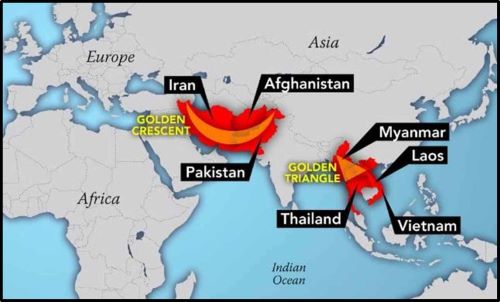Context-
The northeast region of India has long been plagued by separatist insurgencies, with Manipur serving as a critical border state vulnerable to the illicit drug trade emanating from the Golden Triangle. This region, comprising portions of Myanmar, Laos, and Thailand, has become synonymous with the production and trafficking of narcotics, posing significant challenges to India's internal security. The nexus between insurgent organizations and transnational drug syndicates in Manipur has profound implications, shaping the socio-economic landscape and exacerbating existing security concerns.
The Golden Triangle: A Hub of Illicit Drug Production
The historical, geographical, and socio-economic factors have converged to establish the Golden Triangle as a prominent hub for opium cultivation and synthetic drug production. The rugged terrain and porous borders of this region have facilitated illicit activities, making it difficult for law enforcement agencies to curb drug trafficking effectively. Moreover, poverty and weak governance further fuel the narcotics trade, with many farmers turning to opium cultivation as a means of livelihood. The United Nations Office on Drugs and Crime (UNODC) reports a concerning rise in synthetic drug production, particularly methamphetamine, originating from the Golden Triangle, exacerbating the challenge for regional security.
Insurgency and Narco-Trafficking in Manipur
Manipur's history is marred by ethnic conflicts, separatist movements, and narco-trafficking, with numerous active insurgent groups operating in the region. Despite efforts to integrate some insurgents into mainstream society, many continue to pursue separatist agendas, resorting to illicit activities for funding. The proximity of Manipur to opium-producing regions in Myanmar has made it a strategic transit point for drug smuggling into India. Insurgent groups, such as the United National Liberation Front (UNLF) and Kuki-Zo, have diversified their revenue streams to include narco-trafficking, exploiting the porous borders and weak governance structures.
Routes of Trafficking in Manipur
The geographical proximity of Manipur to opium-producing regions in Myanmar facilitates the trafficking of narcotics into India. Entry points such as Behiang and Moreh serve as conduits for drug smuggling, with narcotics further distributed across India via established routes. The lack of formal economic opportunities has perpetuated a reliance on illicit activities, reinforcing the nexus between insurgency and narco-trafficking. The manipulation of porous borders and the absence of effective law enforcement mechanisms exacerbate the challenges faced by authorities in combating drug trafficking.

Interconnection between Insurgency and Drug Trafficking
Manipur's border with Myanmar provides a conducive environment for transnational criminal organizations to collaborate with local insurgent groups, giving rise to a phenomenon known as "narco-insurgency." The financial needs of insurgent groups for sustaining operations have led to alliances with drug traffickers, leveraging the instability in Myanmar to further their illicit activities. Recent data indicates a correlation between increased drug production in Myanmar and heightened drug seizures in Manipur, underscoring the interdependence between insurgency and narco-trafficking.
Challenges Ahead
The surge in drug influx, coupled with ethnic strife and insurgency, has fueled drug abuse among Manipur's youth, contributing to public health crises such as HIV/AIDS. The Free Movement Regime (FMR) along the Indo-Myanmar border, intended to foster bilateral relations, has been exploited by insurgent groups for illegal trafficking activities. Additionally, the nexus between insurgency and narco-trafficking has spawned an informal economy, hindering formal trade and impeding economic growth in the region.
Conclusion
The nexus between insurgency and narco-trafficking in Manipur represents a significant challenge to India's internal security and socio-economic development. The prevalence of illicit drug trade, exacerbated by weak governance and porous borders, underscores the need for comprehensive strategies to address this multifaceted issue. Initiatives such as the "War on Drugs" and the implementation of a "smart fence" along the Indo-Myanmar border are steps in the right direction but require sustained regional cooperation and concerted efforts to mitigate the pervasive influence of narco-insurgency. As India's Act East Policy seeks to strengthen ties with ASEAN countries, addressing the nexus between insurgency and narco-trafficking in Manipur becomes paramount for regional stability and security.
|
Probable questions for UPSC Mains Exam- 1. Discuss the nexus between insurgency and narco-trafficking in the northeast region of India, with a specific focus on Manipur. Analyze the factors contributing to this nexus and its implications for India's internal security. (10 Marks, 150 words) 2. The Golden Triangle has emerged as a hub for illicit drug production, posing significant challenges to regional security. Evaluate the role of weak governance, porous borders, and poverty in facilitating drug trafficking in the Golden Triangle region. How does this phenomenon impact India's security concerns in the northeast? (15 marks, 250 words) |
Source- VIF









